Otherwise Unseeable
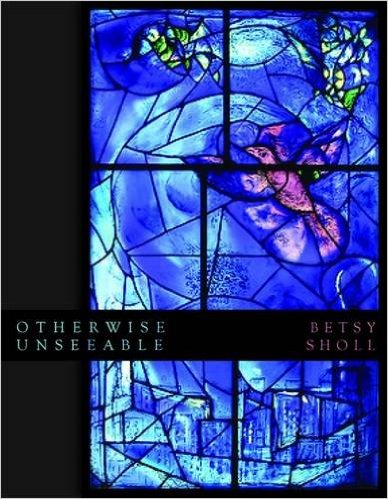
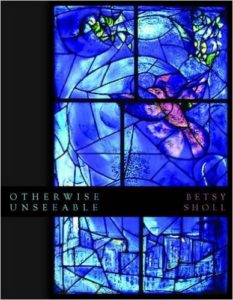 by Betsy Sholl,
by Betsy Sholl,
University of Wisconsin Press, 2014,
78 pages, paper, $16.95,
ISBN: 978-0299299347
Buy the Book
How can we properly cherish the beauty in the world while also embracing its harsh realities? In Otherwise Unseeable, Betsy Sholl’s eighth book of poetry, the author investigates this paradox in both personal and political narratives, with a hungry lyric that could only come from someone who’s survived much. Whether re-writing a Brothers Grimm fairy tale, painting a portrait of a burnt-out gambler, or reconciling feelings over the loss of a parent, Sholl offers a rich tapestry of insight and humanity.
Sholl’s mastery shines in her ability to show us a well-known idea from a new angle. This is most evident in poems that take on fairy tales, as in “Rumpelstiltskin,” “The Woodcutter,” and, especially, “Frog to Princess” which retells the Frog Prince story from the perspective of a frog with no ambitions of becoming royalty:
Yes, I’m a croak cloaked in green slime,
a bulging gullet, a mouth full of mud.
But with great quads, Princess, and a tongue
quicker than flies. If you kiss me you’ll taste
where life comes from, its quagmire scum . . .
. . . Not your marble halls and canopied bed . . .
With great music and humor, Sholl introduces us to a re-envisioned frog who is proud of his slimy grit and has come to teach the princess a lesson, noting that her “world paves over what it needs most.” The frog is the gut, the instinct for telling “whether the world’s going on or out.” He warns: “Without me and my kind, Princess, no pond baubles bubbling up new life.” Wishing for a handsome prince is actually the princess’s downfall, because she is waiting for something better to come along while ignoring the muck of life. The frog insists that the princess’s dream of the prince is “a curse, the world’s hearse. I’m what you need . . . the world’s wettest sex, green putty — right here — in your hand.” With this retelling, Sholl asserts that we need to not only accept life the way it is, warts and all, but also to seek to understand the messiness. By wishing for something else — a different lover, a bigger bank account, what have you — we miss the chance to create our lives, with “green putty,” in the often-grimy reality in which we exist.
Another element consistently present in this collection is that of wind as a visceral image to depict life itself and its never-ending changes. From the “voice of mist” that enters in “Alms” to the tumultuous currents that create music in “Wood Shedding,” “Bass Flute,” and “The Aging Singer,” to an exacting characterization in “The Wind and the Clock,” one cannot read this book without becoming roused by “its little eddies.” In particular, “Vanishing Act,” a poignant lyric on the looming reality of death, starts quietly:
Over the phone we’re already bodiless,
though remember, Love, sound has a source
and even a kiss made of mist
can touch a cheek and lodge in the mind.
But the lyric soon builds. The kiss of mist demonstrates how even a whisper can make an impact and set off a flurry of thoughts and emotions, and as the poem continues, the speaker frets over whether she or her partner will die first:
I can’t help fretting about our next porous
existence, which one of us
will go first, last breath disappearing
in a crowd of molecules,
while the other is left alone
with a closet full of empty clothes.
The porous existence extends the wind/air metaphor, depicting death as a process of evaporating into another dimension: That imagined last breath that vanishes into molecules might as well be a crowd of ghosts. But to land, finally, on the image of empty clothes makes the speaker’s fears heartbreakingly solid.
Later in the poem, she states plainly: “Until it’s our turn, what do we really know?” It is a haunting truth of being human that we don’t know what death and beyond will be like, and yet we have to live with this ominous unknown, and what’s more, accept the end of our beloveds. However, the speaker continues to say that “even despair . . . is good,” and can inspire us to live more fully, even “cause a woman / warming herself under five skirts / to throw back her head and sing.” With great skill, here, Sholl gets at our fear of death while still managing to invoke hope. It’s another version of the message from the frog in the swamp: Sholl challenges us to stop resisting and step into the difficult feelings that hold us back from actually living.
But to limit the value of these poems to their spiritual message would be a disservice. It’s Sholl’s ability to withhold sentimentality, execute dynamic language, and to choose images strategically that make her poems powerful. What’s more, this book inspires the writing of poems — what could be a better gift than that? Amongst the many images burned into my memory — a deaf woman pounding the side of her head, a tramp stamp tattoo in the shape of a dog, a fragile parent in form of a tea cup — the simple image of a gold finch seems most apt at describing the poet herself: “How fragile genius is, anxious, always ready to leap from the sill, always an eye out for the informer.”
— Kristen Stake
Cactus Body
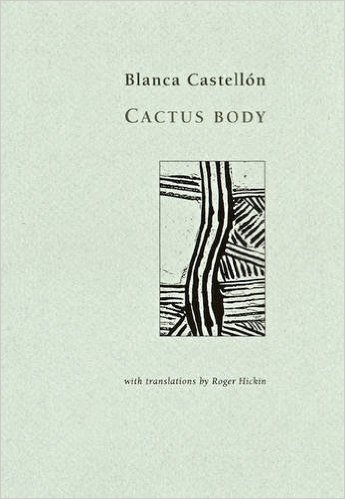
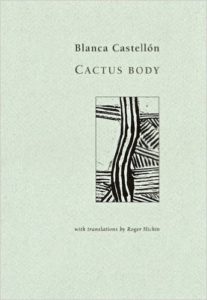 by Blanca Castellon,
by Blanca Castellon,
Translation by Roger Hickin,
Cold Hub Press, 2014,
44 pages, paper, NZ$19.50,
ISBN: 978-0-473-26533-5
Buy the Book
Blanca Castellon’s slim Spanish and English chapbook, Cactus Body, is one I’ve returned to regularly this past year, thanks to New Zealand poet Roger Hickin’s eloquent translations. Castellon, from Nicaragua, manages in the eleven poems collected here to be both political and lyrical. Mario Vargas Llosa has said that, in the western world, “to be a writer means, generally, first (and usually only) to assume a personal responsibility,” but that to be a writer, in at least some Latin American countries (Nicaragua makes his list), means “to assume a social responsibility.”
Blanca Castellon certainly gives us the personal in Cactus Body. In “From B. to B.” (with the parenthetic subtitle “When I lose myself ”), she writes a poem about herself addressed to herself. If someone at an open mic prefaced the reading of a poem with such a description, I’d head quickly for the doorway, but Castellon pulls it off, sounding neither narcissistic nor solipsistic. Of her absent self, she says:
I guess you’ve used
your wings
and risen
to the clouds
you like so much
. . .
Blanca, come down
I need you
and a sudden breeze
brought tears to my eyes
One suspects it’s her muse she misses (“Dear Blanca / I haven’t seen you of late”) though the wistful rather than urgent tone suggests inspiration might soon return.
Inspiration comes up again in “Vademecum,” another delightfully personal meditation in which she identifies poetry as a calling without regard to place or time, and tells us that stereotypes of the poet should be ignored.
To be a poet
the main thing is to be a poet
no matter if you wear
a moth-eaten overcoat
a beret
an earring
or tails
…
to know by heart
the best route to take
to the great beyond
and back
This poem is not about calling out poseurs and poetasters; it celebrates a universal vocation, “be it dust in love / you breathe / or Marilyn Monroe you invoke.”
Yet Castellon does not fail to do her Latin American duty. “Outside Times Ten and One Within” is a political poem of 11 sections, which in Hickin’s terse translation evokes Juan Gelman’s poems about Argentina. In Part IX, Castellon tells us:
The poor come back
to die in traps
there’s hunger
and a closed horizon
there’s dust
bones
and a welter of bodies
in a common sky.
Those last lines recall Gabriel Garcia Marquez’s discussion of how many people have died because of political tyranny in Central and South America. The sense of menace here is amorphous and not identified with any one war, coup, or despot, but in Part IV she writes:
field on field
Of lamentation
there’s Washington
Iraq
Somalia
Haiti
Yet the volume does not end with the sense of defeat that Carlos Fuentes once identified as a distinctly Latin American affliction. In “Anonymous Tree,” her nature poet’s heart leaps up as she observes a tree which “beckons lovingly” and is “utterly green / and lush with mysteries.” In “Sometimes However Earth Is Affectionate,” she seems to be writing about some imagined setting where the earth is fecund, friendly, and evocative of joy. There is no repression or imminent violent death in sight.
Appropriately, she concludes with a poem called “Birth.” What’s being born is a poem whose “cactus body” she tells us, “stores water, for days of thirst.” Castellon’s poems, thanks to Hickin, have been a source of sustenance for this reviewer, who hopes to keep drinking, and to hear from both of them again soon.
— Kevin Sweeney
The Gorgeous Nothings
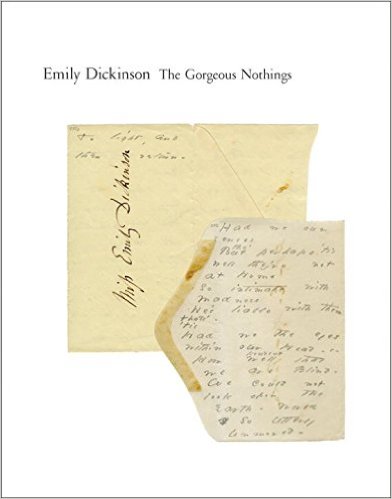
 by Emily Dickinson,
by Emily Dickinson,
edited by Marta Werner and Jen Bervin with a preface by Susan Howe,
New Directions /Christine Burgin, 2013,
hardcover, 272 pages, $39.95,
ISBN: 978-0-8112-2175-7
Buy the Book
The Gorgeous Nothings volume finally collects the poems that Emily Dickinson wrote on the backs of envelopes. This effectively presented text holds myriad clues for present day readers, poets, and scholars, as these odd, almost unclassifiable scraps of paper provide an amazing window into the way Dickinson worked.
Building on poet Susan Howe’s insight in The Birth –Mark, that the manuscripts “should be understood as visual productions,” this volume presents a whole new side to Dickinson’s work that has implications for the treatment of other writers’ work as well. Co-editors Jen Bervin and Marta Werner make a key decision to set transcripts of Dickinson’s poems on left-hand pages, opposite facsimiles of the envelopes on which Dickinson first penned them, on the right-hand pages. The volume also includes a scholarly apparatus consisting of a preface by poet Susan Howe, an introduction and visual index by visual designer Jen Bervin and, at the back of the book, an essay, formal listing and bibliographical description of the envelope manuscripts by scholar Marta Werner. If you are a fan of Dickinson’s poems, or a poet, I suggest begin with the presentations of the poems themselves, and only then delve into the scholarly sections to enhance your reading of the poems.
Even if you’ve not read a lot of Dickinson before opening this book, the poems presented in graphic form will convey how Emily Dickinson created her world one poem at a time. For example, the first poem, about an inner shipwreck, unfolds in two dimensions, in text and on paper:
On the text level, the reader can follow Dickinson laying down lines word by word, like a bricklayer, until she comes to a decision point and stack her words on top of each other: The poem sets up a number of oppositions: “havoc” and “damage,” “tale” and “witness,” “mighty freight” and “dread occasion,” “sea” and
“land.” Taken together, they convey states of the human mind as items lost at sea or freight destroyed on land; they express the foundering and despair of the human mind.
On the paper level, you can watch how Dickinson, like a builder, uses the space, folds, and boundaries of the envelope. Wide spaces between lines allow her to stack her word choices, and the envelope’s shape conveys the sense of a closed tomb “that told no tale and let no witness in.”
Even though Dickinson would never have suspected that her envelopes would be read by her readers in this way, The Gorgeous Nothings presents her work with such simplicity and intimacy that the reader feels almost as if Dickinson were there at the same small table, allowing the reader to look over her shoulder as she drafts. I’ve only found a handful of books that let you have this kind of close contact with a poet actually in the act of drafting. Curtis Bradford’s Yeats At Work is one, and The Gorgeous Nothings is another. The co-authors Marta Werner and Jen Bervin deserve enormous credit, as does poet Susan Howe for her thoughtful introduction. New Directions editor Christine Burgin, in association with Granary Books, has produced a thoroughly agreeable volume that yields new surprises every time the reader opens the covers.
Once the reader has made these discoveries in the poems themselves, there is time to turn attention to and admire the generations of scholars whose work lies behind this volume, the Amherstites vs. the Harvardians, and how eventually good sense prevailed to share with the world the folder that the first scholar had labeled Dickinson’s “scraps.” The backstory shows how easily these poems could have been lost.
In bringing these poems to light, with well-conceived layout, design, and scholarly context, Bervin and Werner allow the reader a sense of Dickinson’s process in finding “the certain slant” and choice of words that make each poem arrive at and convey its present moment. As the Danish poet and scholar Niels Kjær has written, this presentness is the hallmark of Dickinson’s
work, and The Gorgeous Nothings lets us experience it up close. Such intimacy makes this work not only a scholarly tour de force, but the freshest presentation of Dickinson’s poems to have come to us in a very long time.
— Mark Schorr
Churches
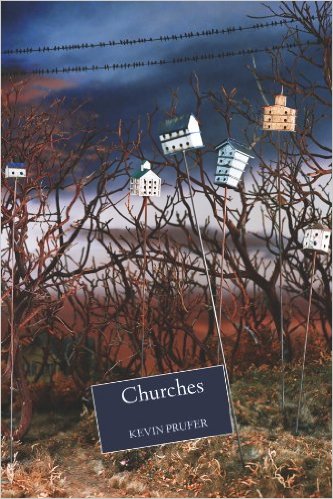
 by Kevin Prufer,
by Kevin Prufer,
Four Way Books, 2014,
paper, 96 pages, $15.95,
ISBN: 978-1-935536-43-7
Buy the Book
Many of the poems in Churches, by Kevin Prufer, are full of fire, smoke, and broken glass. Their speakers often find themselves in a world figured as a womb of violence, forced to face — without the solace of religious abstraction, and often under the harshest of conditions — human mortality. Out of these wombs is born, for the reader, a necessity to contemplate the role of faith in our attempts to survive and understand the harm done to us by circumstances, or by others, but also to consider that the harms we suffer are often of our own doing. These poems frequently illustrate the failure of the coping mechanisms that we have come to rely upon in a post-Nietzschean world where religious faith is either absent, or, even worse, destructive.
The opening poem in Churches, titled “Potential Energy is Stored Energy,” highlights this question of faith. A porter lying in the snow, a victim of the explosion of a bomb planted on board a train, thinks of the infant son he and his wife had lost to fever. Neither the porter, now approaching death, nor his wife, in his memory of their son’s passing, voices the supplications a reader might expect. Rather, it is the anthropomorphized bomb that utters its prayers, ominously, to heaven, just before its stored energy is destructively released: “I give this to you, Lord, /in a wisp of smoke, in splinters /scattered in the wind and love.” These final words of the bomb are set beside the porter’s last moments in which present and past have become one, and his wife’s words to their fevered infant are now applicable also to himself: “Oh breathe, breathe, his wife was saying, /while the great unmelting snows concealed his eyes, /and up to the waiting heavens /this black plume rose.” The God of the poem is the God of bombs (and bombers) and while his heaven may be waiting, it is a heaven that admits only the smoke of wreckage.
If religious faith can no longer be of any consolation, then where do we seek solace against a harsh world? One replacement for faith, portrayed as largely ineffective and even harmful, is the numbing power of medication. The little white paper pill cup is ubiquitous throughout the book, a grail in which the speakers of the poems often seek solutions. That white cup looks bright against a backdrop of black smoke, but it is a brightness, the poems seem to argue, that obscures rather than reveals — its promise of cure seems as unreal, as unattainable as heaven. The poem titled “Paper Cup” offers the constant refrain “Here are your pills” until, in its final line, we are told: “Here are the last of your pills, little white zeros in a cup.” In a world that rains down the pain-killer Lortab like manna, there still aren’t enough pills to cure what ails us.
Churches approaches the existential problem of the death of God primarily in order to illustrate both the insufficiency of our answers and the effects of this failure. Consider the elderly speaker of “Sunday Afternoon in the Park” who, rather than being situated in the scene of the title is, instead, a mere observer, trapped within the linoleum floored world of a retirement home where the orderly’s cry of “Pills, pills, pills” leads the speaker to identify her as “the crazy woman /down the hall.” Such an institutionalized existence pales in comparison to even the quotidian world of people waiting for buses that exists outside the speaker’s window. After making some perceptive observations of the scene, the speaker wistfully, and tragically, declares,
How I love a cool Sunday morning
high above the park
after a rain.
If I could, I would jump
right through this window.
These lines are tragic largely because they illustrate real human potential, struggling, however unsuccessfully, against terms of confinement that, unlike mortality, are not necessary. We don’t have to keep the elderly drugged and shut up in homes, and the poem reminds us that this problem, among others, is man-made. It requires a God neither to blame for it, nor to solve it.
— Christopher Hornbacker


